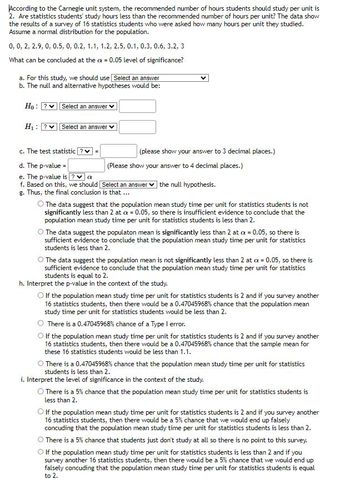
MATLAB: An Introduction with Applications
6th Edition
ISBN: 9781119256830
Author: Amos Gilat
Publisher: John Wiley & Sons Inc
expand_more
expand_more
format_list_bulleted
Question
need help in part D getting result 0.0094 incorrect

Transcribed Image Text:According to the Carnegie unit system, the recommended number of hours students should study per unit is
2. Are statistics students' study hours less than the recommended number of hours per unit? The data show
the results of a survey of 16 statistics students who were asked how many hours per unit they studied.
Assume a normal distribution for the population.
0, 0, 2, 2.9, 0, 0.5, 0, 0.2, 1.1, 1.2, 2.5, 0.1, 0.3, 0.6, 3.2, 3
What can be concluded at the ax = 0.05 level of significance?
a. For this study, we should use Select an answer
b. The null and alternative hypotheses would be:
Ho: ? Select an answer
H₁: ? Select an answer
c. The test statistic ? ♥
=
(please show your answer to 3 decimal places.)
(Please show your answer to 4 decimal places.)
d. The p-value =
e. The p-value is ? ✓ a
f. Based on this, we should [Select an answer the null hypothesis.
g. Thus, the final conclusion is that ...
The data suggest that the population mean study time per unit for statistics students is not
significantly less than 2 at a = 0.05, so there is insufficient evidence to conclude that the
population mean study time per unit for statistics students is less than 2.
O The data suggest the populaton mean is significantly less than 2 at cx = 0.05, so there is
sufficient evidence to conclude that the population mean study time per unit for statistics
students is less than 2.
O The data suggest the population mean is not significantly less than 2 at a = 0.05, so there is
sufficient evidence to conclude that the population mean study time per unit for statistics
students is equal to 2.
h. Interpret the p-value in the context of the study.
O If the population mean study time per unit for statistics students is 2 and if you survey another
16 statistics students, then there would be a 0.47045968% chance that the population mean
study time per unit for statistics students would be less than 2.
There is a 0.47045968% chance of a Type I error.
If the population mean study time per unit for statistics students is 2 and if you survey another
16 statistics students, then there would be a 0.47045968% chance that the sample mean for
these 16 statistics students would be less than 1.1.
There is a 0.47045968 % chance that the population mean study time per unit for statistics
students is less than 2.
i. Interpret the level of significance in the context of the study.
There is a 5% chance that the population mean study time per unit for statistics students is
less than 2.
O If the population mean study time per unit for statistics students is 2 and if you survey another
16 statistics students, then there would be a 5% chance that we would end up falsely
concuding that the population mean study time per unit for statistics students is less than 2.
There is a 5% chance that students just don't study at all so there is no point to this survey.
O If the population mean study time per unit for statistics students is less than 2 and if you
survey another 16 statistics students, then there would be a 5% chance that we would end up
falsely concuding that the population mean study time per unit for statistics students is equal
to 2.
Expert Solution
This question has been solved!
Explore an expertly crafted, step-by-step solution for a thorough understanding of key concepts.
Step by stepSolved in 4 steps with 3 images

Knowledge Booster
Similar questions
- Can you justify the vaule shown in the picture for a case n= 3? what is the value of 5.196, 2pi, and 10.392 stand for?arrow_forwardFrom this geometruc distrubtion. (0.45)8(0.55). What does the 8 represent? 1. Probability of failure 2. Probability of success 3. The number of failurees 4. Number of sucessesarrow_forwardNot understanding how 1.33626 was gotten after plugging in the formuarrow_forward
arrow_back_ios
arrow_forward_ios
Recommended textbooks for you
 MATLAB: An Introduction with ApplicationsStatisticsISBN:9781119256830Author:Amos GilatPublisher:John Wiley & Sons Inc
MATLAB: An Introduction with ApplicationsStatisticsISBN:9781119256830Author:Amos GilatPublisher:John Wiley & Sons Inc Probability and Statistics for Engineering and th...StatisticsISBN:9781305251809Author:Jay L. DevorePublisher:Cengage Learning
Probability and Statistics for Engineering and th...StatisticsISBN:9781305251809Author:Jay L. DevorePublisher:Cengage Learning Statistics for The Behavioral Sciences (MindTap C...StatisticsISBN:9781305504912Author:Frederick J Gravetter, Larry B. WallnauPublisher:Cengage Learning
Statistics for The Behavioral Sciences (MindTap C...StatisticsISBN:9781305504912Author:Frederick J Gravetter, Larry B. WallnauPublisher:Cengage Learning Elementary Statistics: Picturing the World (7th E...StatisticsISBN:9780134683416Author:Ron Larson, Betsy FarberPublisher:PEARSON
Elementary Statistics: Picturing the World (7th E...StatisticsISBN:9780134683416Author:Ron Larson, Betsy FarberPublisher:PEARSON The Basic Practice of StatisticsStatisticsISBN:9781319042578Author:David S. Moore, William I. Notz, Michael A. FlignerPublisher:W. H. Freeman
The Basic Practice of StatisticsStatisticsISBN:9781319042578Author:David S. Moore, William I. Notz, Michael A. FlignerPublisher:W. H. Freeman Introduction to the Practice of StatisticsStatisticsISBN:9781319013387Author:David S. Moore, George P. McCabe, Bruce A. CraigPublisher:W. H. Freeman
Introduction to the Practice of StatisticsStatisticsISBN:9781319013387Author:David S. Moore, George P. McCabe, Bruce A. CraigPublisher:W. H. Freeman

MATLAB: An Introduction with Applications
Statistics
ISBN:9781119256830
Author:Amos Gilat
Publisher:John Wiley & Sons Inc

Probability and Statistics for Engineering and th...
Statistics
ISBN:9781305251809
Author:Jay L. Devore
Publisher:Cengage Learning

Statistics for The Behavioral Sciences (MindTap C...
Statistics
ISBN:9781305504912
Author:Frederick J Gravetter, Larry B. Wallnau
Publisher:Cengage Learning

Elementary Statistics: Picturing the World (7th E...
Statistics
ISBN:9780134683416
Author:Ron Larson, Betsy Farber
Publisher:PEARSON

The Basic Practice of Statistics
Statistics
ISBN:9781319042578
Author:David S. Moore, William I. Notz, Michael A. Fligner
Publisher:W. H. Freeman

Introduction to the Practice of Statistics
Statistics
ISBN:9781319013387
Author:David S. Moore, George P. McCabe, Bruce A. Craig
Publisher:W. H. Freeman